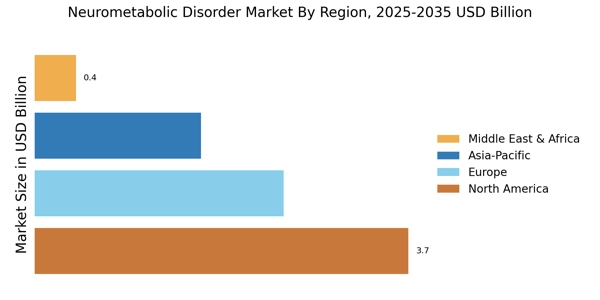Regulatory Support for Treatment Approvals
Regulatory support for the approval of new treatments is a significant driver for the Neurometabolic Disorder Market. Regulatory agencies are increasingly recognizing the need for expedited pathways for therapies targeting rare and complex neurometabolic disorders. This supportive environment encourages pharmaceutical companies to invest in the development of novel treatments. Recent initiatives aimed at streamlining the approval process for orphan drugs are indicative of this trend. As more therapies gain regulatory approval, the availability of treatment options for patients is likely to expand, thereby enhancing the Neurometabolic Disorder Market. This regulatory landscape may also foster innovation, as companies seek to address unmet medical needs.
Increased Awareness and Education Initiatives
Increased awareness and education initiatives are playing a vital role in shaping the Neurometabolic Disorder Market. Healthcare professionals and the general public are becoming more informed about the symptoms and implications of neurometabolic disorders. Campaigns aimed at educating both patients and providers are leading to earlier diagnoses and improved patient outcomes. This heightened awareness is likely to result in increased demand for diagnostic tests and treatment options, thereby driving market growth. Furthermore, educational programs are fostering collaboration among researchers, clinicians, and patients, which may lead to innovative solutions and improved management strategies within the Neurometabolic Disorder Market.
Growing Investment in Research and Development
Investment in research and development is a crucial driver for the Neurometabolic Disorder Market. Pharmaceutical companies and research institutions are increasingly allocating resources to explore novel therapeutic options and improve existing treatments. This trend is evidenced by the rising number of clinical trials focused on neurometabolic disorders, which have seen a significant uptick in recent years. The global market for neurometabolic disorder therapeutics is projected to reach several billion dollars by the end of the decade, reflecting the potential for lucrative returns on investment. As more stakeholders recognize the unmet needs in this area, the influx of funding is likely to accelerate advancements in treatment modalities, thereby enhancing the Neurometabolic Disorder Market.
Technological Advancements in Diagnostic Tools
Technological innovations in diagnostic tools are transforming the landscape of the Neurometabolic Disorder Market. Enhanced imaging techniques, next-generation sequencing, and advanced biomarker identification are facilitating earlier and more accurate diagnoses. For instance, the introduction of high-throughput screening methods has significantly improved the detection rates of metabolic disorders. This technological evolution not only aids in timely intervention but also fosters the development of targeted therapies. As diagnostic accuracy improves, healthcare providers are better equipped to manage these complex disorders, which is expected to drive growth in the Neurometabolic Disorder Market. The integration of artificial intelligence in diagnostics may further enhance this trend.
Increasing Prevalence of Neurometabolic Disorders
The rising incidence of neurometabolic disorders is a pivotal driver for the Neurometabolic Disorder Market. Conditions such as phenylketonuria and mitochondrial disorders are becoming more prevalent, leading to heightened demand for diagnostic and therapeutic solutions. Recent estimates suggest that the prevalence of these disorders may be as high as 1 in 5,000 live births in certain populations. This increasing prevalence necessitates the development of specialized healthcare services and products, thereby propelling market growth. As healthcare providers become more aware of these conditions, the need for effective management strategies and innovative treatments is likely to expand, further stimulating the Neurometabolic Disorder Market.


















Leave a Comment